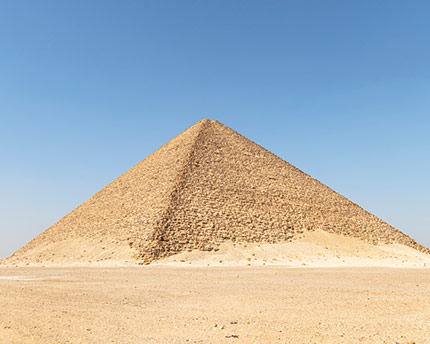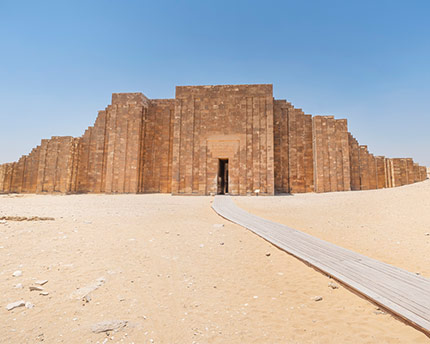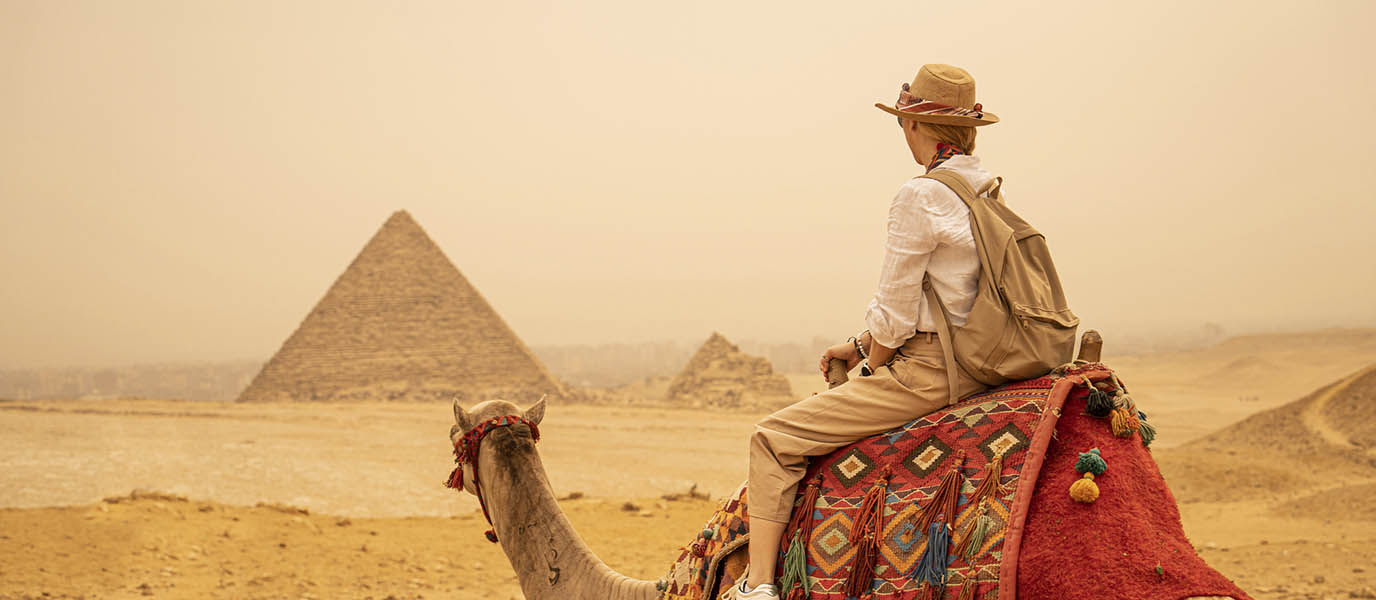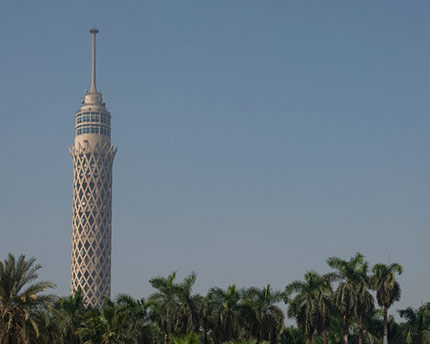This pyramid, built for the pharaoh Snefru during the Fourth Dynasty, was the third pyramid to be built in Egypt — and the largest in the necropolis of Dahshur. No doubt, you will be wondering how it got its name, and no, it has nothing to do with blood: it is because of the reddish tint the structure takes on at sunset. If you wait patiently at this time, you will see it develop a fiery glow. According to Egyptologists, the pyramid did not always have this appearance, but had a cladding of Tura limestone, making it brilliant white. If you look carefully, you can see the remains of the limestone covering around the base of the pyramid. If you’ve visited Cairo before, you will be familiar with this type of stone.
Although the fame of the Giza Pyramids and everything around the necropolis has eclipsed others, such as the Saqqara complex, and the one at Dahshur, our present subject, it is well worth including them on your itinerary, as they are fascinating. Each has its own interesting history, and they all demonstrate the sophistication of the dynasties that ruled Egypt. Below, we give you a brief outline of the history of the Red Pyramid, and some interesting facts about it.
The history of the Red Pyramid
The Red Pyramid of the pharaoh Snefru (or Seneferu) stands within the necropolis of Dahshur, just over a kilometre away from another important pyramid, the Layer Pyramid. It even has the same 43° incline, almost 10° less than the country’s other pyramids. This pyramid was built during the Fourth Dynasty, around 2582 B.C., and represents a milestone, as it was the first to be built with completely smooth walls. Its sides measure 220 metres across, and it is 104 metres tall.
This burial site was first studied in 1839 by the Egyptologist John Shae Perring who measured the monuments and managed to find his way inside. Investigations continued from that date onwards, but it was only in 1980 that the German researcher Rainer Stadelmann took over, and tried to throw some light on the pyramid’s still undiscovered secrets.
The interior is accessed from the northern side along a narrow passage, 1.2 metres high, which slopes slightly downwards. About 67 metres further on are the Royal Chambers, measuring 8 x 3 metres, with a ceiling that reaches 12 metres in height. Next to this is another, similar room, located right at the centre of the pyramid. There is also a third chamber, accessed via the second one, which has an east-west orientation — unlike the others which are orientated north-south.
Interesting features of the Red Pyramid
Among the interesting features of the Red Pyramid are its smooth walls. The German team who took up the research were able to reconstruct its pyramidion or capstone, the stone that sits at the apex of a pyramid. This can now be seen close to the pyramid; it has a base area of 1.57 metres — and it is the only one from the Ancient World to have been preserved! Of course, the pyramidion was also originally clad in Tura limestone.
An interesting fact about the Red Pyramid is that in order to build it, the Ancient Egyptians had to move around 3.2 million cubic metres of stone — more than was used in the Cheops Pyramid (which barely exceeded 2.5 million cubic metres). Its shape is also unusual: it is very wide and low for its base, as its angle of incline is 10° less than the norm.
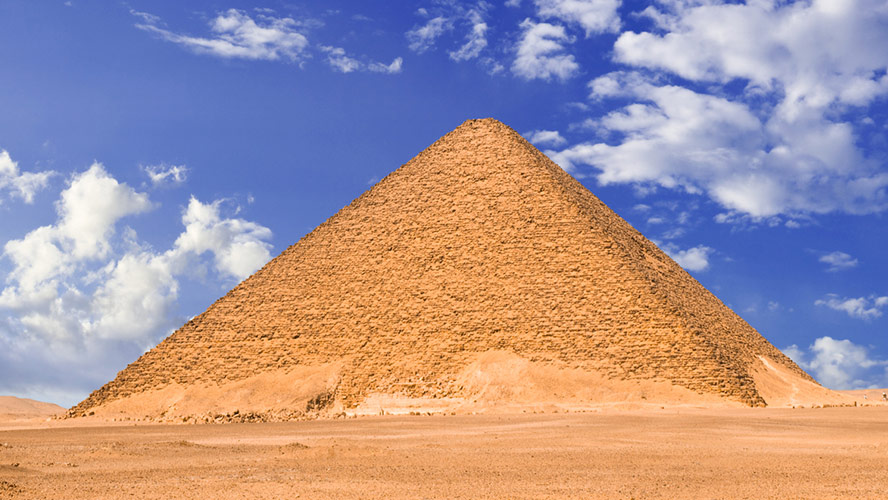
Dahshur
The town of Dahshur lies 40 kilometres from Cairo on the western bank of the Nile. This place attracts a good number of visitors because the municipal area is also home to an important royal necropolis with some pyramids as well preserved as the Red Pyramid (which we have discussed at length) and the Layer Pyramid. This necropolis belongs to the Twelfth Dynasty and the reign of the pharaoh Amenemhat II. Although this pyramid is in an advanced state of deterioration, there are others of interest to lovers of history and archaeology.
Where to eat near the Red Pyramid
In Dahshur, you will find a few small restaurants where you can recharge your batteries, but one alternative is to go to the Saqqara area, where there is much more choice, or even to return to Cairo to enjoy one of its splendid restaurants. A few kilometres from the Red Pyramid, you will find the Sakkara restaurant, which offers simple home-made fare in an informal atmosphere. Another option, just a few minutes’ drive away, is the Pharous restaurant, which is very authentic, despite being popular with tourists. It is housed in a nomad tent, and often has live music. Either of these options will not disappoint.
Where to stay near the Red Pyramid
We recommend that, rather than staying in Dahshur, where the Red Pyramid is located, you opt instead for Cairo, as then you will be able to enjoy the city’s lively nightlife and its varied gastronomic scene. If you do stay in the Egyptian capital, an excellent hotel is the four-star Barceló Cairo Pyramids, which enjoys a good location, and has well-kept facilities where you can enjoy a few days of relaxation. In addition to its 236 attractive guest rooms, the hotel also offers interesting, high quality cuisine in its bars and restaurants. One even has a terrace with views of the Giza Pyramids. Facilities include a swimming pool, gymnasium and Wellness Centre. The perfect base from which to explore Cairo and the surrounding area.




































































